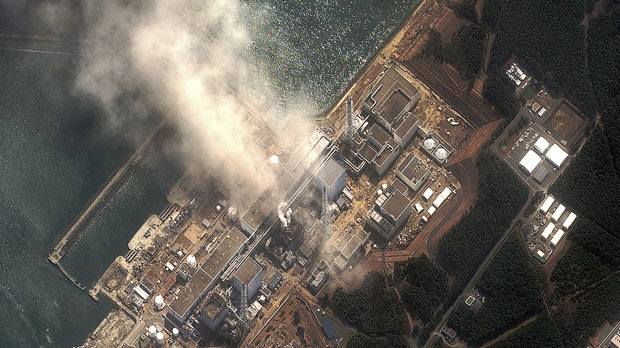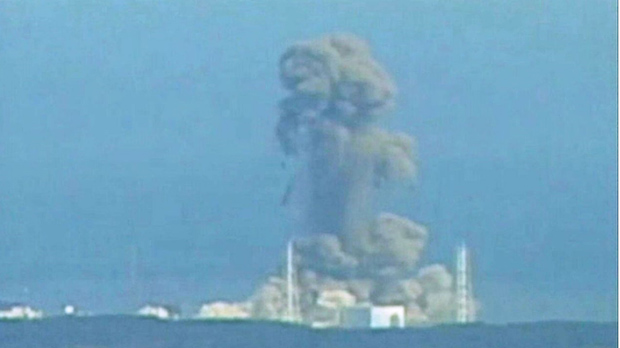Japan: second explosion rocks Fukushima nuclear plant
Another explosion hits Fukushima nuclear plant, damaged in Friday’s earthquake and tsunami. Many are frightened – but this is not another Chernobyl, as Science Correspondent Tom Clarke explains.
The hydrogen blast was the second at Fukushima nuclear plant, after an explosion at another reactor on Saturday following damage from the earthquake and tsunami in Japan.
The plant operator, Tokyo Electric Power (TEPCO), said 11 people had been injured but stressed that the core container of the reactor, No 3 reactor, remained intact.
What the Japanese Government are trying to do is consistent with a major radiological disaster. Nuclear expert John Large
TEPCO said: “An explosive sound followed by white smoke occurred at the reactor building of the Unit 3. It was believed to be a hydrogen explosion.
“According to the parameter, it is estimated that the reactor containment vessel remains intact. However, the status of the plant and the impact of radioactive materials to the outside environment are presently under investigation.”
Get the latest on our Japan live blog
Failure
The operator said that the cooling systems at another reactor – No 2 reactor – had now also failed and experts warned Channel 4 News there could be another explosion.
Around 170,000 people have already been evacuated from the area surrounding two nuclear plants in Fukushima after Saturday’s explosion at the first reactor – No 1 – blew the roof off a building at the plant, caused a partial meltdown in the reactor, and released low-level radiation.
The explosions are not nuclear explosions, but have been caused instead by the nuclear fuel rods overheating, after the water coolant systems failed. As the fuel rods and their casings melt, they react with the remaining water in the system, producing hydrogen. This builds up and eventually causes a hydrogen explosion due the pressure. The hydrodgen was “vented” from the inner containment vessels, but at least in No 1 reactor, the blast destroyed the outer vessel.
But the Japanese Government and plant operator stress that the radiation levels around the plant remain low. Yukio Edano, Japan’s Chief Cabinet Secretary said the inner containment vessel that holds the nuclear fuel rods is safe and that the chances of a radioactive leak were “low”.
Nuclear expert John Large told Channel 4 News: “The public perception is that all things nuclear are a fate worse than death, so governments are always conservative, saying that it is only low level radiation.”
He said that evacuations were a sensible option for the Japanese Government, regardless of the eventual severity of the accident.
“But what they are trying to do – getting people to shelter and evacuating them, the only thing they can do in the aftermath of a nuclear incident – is consistent with a major radiological disaster, either occurring or impending,” he said.

Five reasons why this is not Chernobyl
Channel 4 News Science Correspondent Tom Clarke explains the five key reasons why the blasts in Japan are not Chernobyl.
1. The three stricken reactors at the Fukushima plant were shut down automatically when the quake was detected. The blast at the Chernobyl plant occurred while the reactor was operating at full temperature meaning there was far more energy in the explosion. Far more radioactive material was blasted far further.
2. The explosions at the No 1 and No 3 reactors were due to a mixture of hydrogen gas and air outside the reactor vessel which is made of a 20cm-thick steel casing. At Chernobyl a chemical reaction in the reactor itself caused it to explode. At Chernobyl some of the nuclear fuel and radioactive reactor components were vaporised and blasted into the environment.
3. The radiation released from Fukushima is in the form of steam from water that is being, used to cool the reactor. This water will contain some potentially dangerous radioactive elements like iodine and caesium – but only small, if any quantities, of radioactive fuel. Far more radioactive materials of more dangerous forms, were ejected in the Chernobyl blast.
4. Many people were evacuated from the area surrounding Fukushima before the first and second explosions. An evacuation from the Chernobyl area was not begun until some time after the blast.
5. The Japanese authorities put an immediate ban on consuming food exposed to the environment around Fukushima and issued iodine tablets to reduce the risk of cancer from radioactive iodine exposure. At Chernobyl iodine was not given out to those exposed and people, including children, continued to consume contaminated products like milk, weeks after the accident.
At least 22 people have been contaminated as the authorities maintain a 20km evacuation zone and warn people to stay indoors. Up to 190 may have been exposed to radiation, the authorities fear, as workers in protective clothing use hand-held scanners to check people arriving at evacuation centres.
The key issue is people breathing in the radioactive particles which have been released as a result of the explosions. Iodine tables have been given out to try and mitigate the effects, and prevent radioactive iodine being absorbed in the body.
I would expect the Japanese Government now, today, to say yes, this is really serious. John Large
US warships providing aid moved away from the coast temporarily because of low-level radiation caused by the second blast. Several other nuclear plants across Japan also remain unstable as a result of overheating.
Mr Large said: “There are war ships geared up to fight in a nuclear battlefield – they want to know if they are under nclear attack. So they are very reliable.”

(Internet picture of the blast at No 3 reactor in Fukushima from Rodrigo’s Tumblr)
Attempts by nuclear officials to prevent another explosion by pouring sea water into the plant – a last ditch attempt, as the station will never again produce power after this intervention – appear to have failed.
Meltdown
Mr Large said the believed that there had been a meltdown in No 1 reactor, and stressed that the explosions were major events, even though it could be that only incidental radiation is being released at the moment if the inner cores in the reactors remain complete.
“I would expect the Japanese Government now, today, to say yes, this is really serious,” he said.
“From the violence of these explosions I would have expected some kind of radioactive matter from the fuel in the atmosphere – because the explosions were so energetic I would expect dispersion, and disposition – where it comes down – some kilometres away from the reactor.”
He added: “I don’t want to be a doom merchant but if I put the jigsaw of these incidences together, it looks very serious – particularly with No 2 reactor still overheating – this really shows a fundamental flaw in our safety culture all over the world, and will be a significant knock on public confidence.”
How serious is this?
On the International Nuclear Event Scale, the events in Japan have been rated a four.
Nuclear engineer John Large explains: "To give you an example, one is someone dropping a milk bottle in the control room, and Chernobyl [a nuclear accident in the Ukraine in 1986, which killed between 31 and tens of thousands of people over the long-term] is seven."
Three Mile Island, a nuclear incident in 1979, was rated 5, he said. This incident seems more similar to what is happening in Japan - there was a meltdown in the core and some radiation released, but no major leak.
Around 12,000 people in the "at risk group" were told to evacuate in 1979, including pregnant women, but 485,000 left the area as panic spread.
"Any harm was fairly low because people got out of the way," said Mr Large. "It could be that that happens in Japan, and it could be that the radioactive release is low."
Exposure to radiation can cause radiation sickness, with symptoms including nausea, vomiting, hair loss, haemorrhage and diarrhoea - and prolonged or severe exposure can cause death.
In Japan, as the radiation is not strong and people have evacuated, experts believe the biggest risk is of radiation breathed in from the air, which could raise incidences of cancer in the long term. Eating food from contaminated crops or animals could also be a long-term risk, as it was in Chernobyl.
Mr Large added: "The real level of severity won't be known until we can determine what health detriment there has been in the communities. And that may never be known because natural cancer rates are relatively high and you're trying to pick up numbers beyond the natural incidence."
Disaster
The nuclear crisis is compounding the crisis in earthquake and tsunami-hit Japan, where rescuers are scrabbling to find survivors after a natural disaster in which 10,000 people are feared to have died.
The wave tore across the north east of Japan on Friday after an 8.9 magnitude earthquake – flattening towns and wiping out infrastructure. In one town alone, Minamisanriku, at least 10,000 people are missing out of a population of 17,000.
The Japanese Prime Minister described the earthquake, tsunami and nuclear situation as the “biggest crisis Japan has encountered in the 65 years since the end of World War II.” He said rescuers would do their “utmost” again on Monday to overcome the catastrophe.




